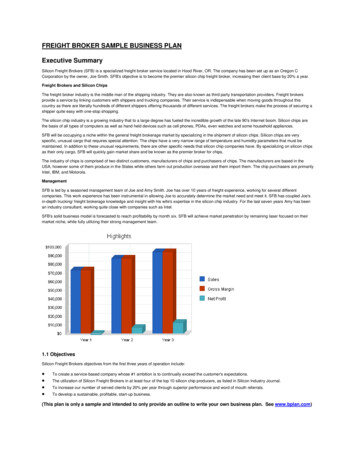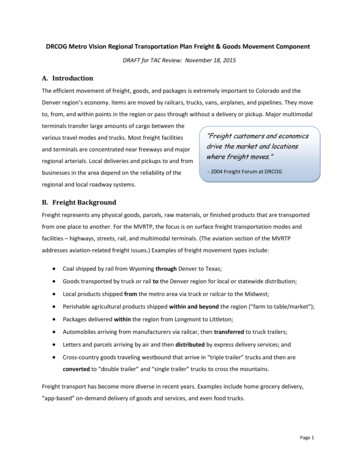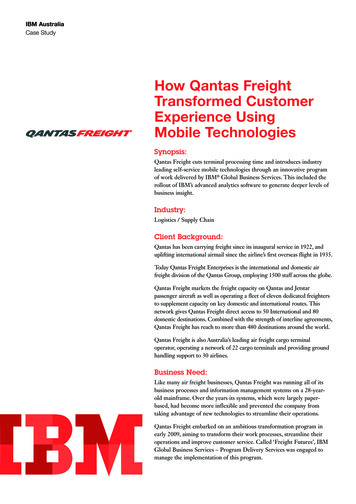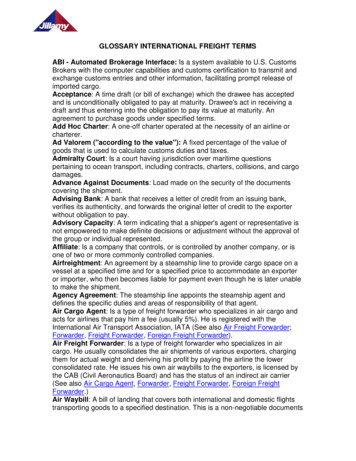
Transcription
FAST Act Guide for Freight Plans and Freight PlanningSummary of the Freight Provisions in the New Federal Transportation LegislationUpdated June 1, 2016OVERVIEW: Freight Emphasis and Dedicated FundingOn December 4, 2015, President Obama signed into law the Fixing America’s SurfaceTransportation (FAST) Act that authorizes Federal highway, highway safety, transit, and railprograms for five years from Federal fiscal years (FY) 2016 through 2020. The FAST Actauthorizes 305 billion from both the Highway Trust Fund and the General Fund (GF) of theUnited States Treasury. It provides 225 billion in Highway Trust Fund (HTF) contract authorityover five years for the Federal-aid Highway Program, increasing funding from 41 billion in 2015to 47 billion in 2020.The bill places major emphasis on freight investments to be supported by the HTF by creatinga new National Highway Freight Program (NHFP) funded at an average of 1.2 billion per yearand distributed to the States by formula. In addition, a new discretionary program entitled theNationally Significant Freight and Highway Projects is established, funded at an average of 900million per year.1This document is a summary of the freight, freight funding and freight planning provisions inFAST. Details on the FAST Act can be found on: 1The AASHTO website Official documents related to the bill can be found on the Congressional WA freight provisions: tsheetNHFP Fact sheet: .pdfNHFP Guidance:http://www.ops.fhwa.dot.gov/freight/pol plng finance/policy/fastact/s1116nhfpguidance/National Highway Freight Network (NHFN) tructure/nfn/index.htmFHWA Fastlane Grant egrants/frequently-asked-questionsAASHTO Summary published December 16, 2015NOTE: The Surface Transportation Program (STP) is renamed the Surface Transportation Block GrantProgram (STBGP).1
Click here to type section # Click here to type title of section Fast Act Freight Questions & Answers:http://www.ops.fhwa.dot.gov/freight/pol plng SUMMARY: Freight and Freight Funding Provisions in FAST Creates a National Multimodal Freight Network (NMFN)o Includes a National Highway Freight Network (NHFN) consisting of foursubsystems, the Primary Highway Freight System (PHFS), Other InterstateHighways not in the PHFS, Critical Rural Freight Corridors (CRFC), and CriticalUrban Freight Corridors (CUFC).Requires USDOT to create a National Multimodal Freight Policy, to be administered by theUSDOT Undersecretary for Policy, to improve the condition and performance of theNMFN.o USDOT must complete a National Strategic Freight Plan every five years that willinclude processes for multi-State project delivery, and financial and regulatorybarriers to freight movement, among other things.Funds Freight: Establishes a new National Highway Freight Program (NHFP) as part ofthe core Federal-aid Highway Program structure. The NHFP will direct Federal resourcesand policies to NHFN improvement.o This formula program is authorized at 6.2 billion over five years, and each State’sshare of the NHFP will be based on the State’s overall share of highway programapportionmentso Flexibility of NHFP dollars within a State will be related to its share of miles on thePrimary Highway Freight System.Repeals the increased (90-95 %) Federal match (in MAP-21) for freight projects oninterstates and highways. However, the Federal NHFP funding match for projects on theinterstate system is 90% and generally 80% for other freight projects.Creates the Nationally Significant Freight and Highway Projects (NSFHP) discretionarygrant program designed for major highway and freight projects funded at 4.5 billion overfive years.Though funded out of the HTF, certain non-highway projects are eligible to receiveportions of the NHFP and NSFHP dollars (for example: Provides eligibility for truckparking and surface transportation infrastructure improvements in port terminals fordirect intermodal interchange, transfer, and port access)SUMMARY: State DOT Freight Planning and Performance MeasuresRequirements 2Mandates all States receiving NHFP formula funds to create a State Freight Plan (SFP)within two years of enactment.o Plans may be either standalone or be part of a State’s long-range transportationplan
Click here to type section # Click here to type title of sectionState freight plans must be coordinated with the performance-based planningprocesso Plans shall include a 5 year forecast period and must be updated not less thanevery 5 yearso Plans must include a freight investment plan, including a list of priority projects,and be financially constrainedo Encourages States to form State Freight Advisory Committeeso Adds language that the long-range transportation plan shall consider public portsand freight shippers (also clarifies what “private providers of transportation”include)o Expands the scope of the planning process to include addressing resiliency andreliability of the transportation systemThe FAST Act provides a number of details of what is required in the multimodal Statefreight plan and the granularity of data and analysis may not be consistent with themanner in which State DOTs currently develop their LRTPs. (details provided in latersection)Directs USDOT to develop freight analysis tools and data but provides no specific funding.This is separate from the performance management data support program.There is no requirement that the MPOs develop any type of separate freight componentfor their long-range plans. Note: MPOs are required to address freight issues in theirLRTP.There are no significant changes to the performance-based planning process establishedin MAP-21, this includes no new national-level performance measures beyond what iscurrently being developed through the Federal rule-making process. However:o Performance Based Statewide Planning must include freight considerations andUSDOT will assess if the State DOT has made significant progress towards theachievement of the freight targets established under 150(d). If the State DOT hasnot, then there are additional reporting requirements but no penalties associatedwith obligating the freight funds.o A Port Performance Statistics Program, requiring ports of certain thresholds toreport annual throughput statistics. (An USDOT) advisory group will report to theSecretary annually on recommendations to improve port efficiency.o Changes existing language to a “shall” regarding the inclusion of description ofperformance measures and the system performance report in a State’s long-rangetransportation plan.States must also report periodically on their progress in relation to the performancetargets. If a State DOT does not achieve or make significant progress toward achievingtargets in any performance measurement area after one reporting cycle, State mustsubmit a report describing the actions they will undertake to achieve their targets in thefuture.o The penalty for falling below the minimum condition levels for pavementson the Interstate system is imposed after the first reporting cycle.o 3
Click here to type section # Click here to type title of sectionSUMMARY FUNDING: State DOTs are to Use Funds to Improve FreightMovement2The FAST Act requires States to obligate NHFP funds for projects to improve the movement offreight on the NHFN. A State’s formula is calculated based upon the number of Primary HighwayFreight System (PHFS) miles in that State relative to all PHFS miles.For States whose formula proportion is greater than or equal to two percent, it may obligatefunds to any of the NHFN network elements except for interstates not part of the PHFS. For Stateswhose formula proportion is less than or equal to two percent, it may obligate funds to anysegment of the NHFN, which would include all interstates. Program eligibilities and featuresinclude: Limiting States to the use of no more than ten percent of apportioned funds on certainnon-highway projects, such as governmental costs associated with rail and intermodalconnectors.Project development activitiesConstruction, reconstruction rehabilitation, and land acquisitionIntelligent Transportation Systems (ITS), including freight ITSEnvironmental mitigation related to freight impactRail-highway grade separationGeometric design improvementsTruck-only lanesRunaway and climbing truck lanesShoulder wideningTruck Parking FacilitiesReal-time information systemsElectronic screening and credentialingTraffic signalsWork Zone managementRamp meteringITS and other technologies for intermodal facilities and border crossingsAdditional road capacity for highway freight bottlenecksAny project that improves flow of freight to the NHFNDiesel retrofitsData collection and analysisPerformance Target developmentSUMMARY FUNDING: Nationally Significant Freight and Highway Projects3The FAST Act creates the new Nationally Significant Freight and Highway Projects discretionaryprogram to provide Federal financial assistance for projects of national or regional significance.234AASHTO Summary of FAST Act – 2015-12-16 FINALAASHTO Summary of FAST Act – 2015-12-16 FINAL
Click here to type section # Click here to type title of sectionGrants must be at least 25 million, and may only be made to State or local government agenciesor groups of multiple agencies. Other features include: Highway freight projects must be on the NHFN or a highway or bridge project on the NHS,including adding interstate capacity.Other freight projects may also include rail, intermodal facilities, projects in scenic areas,and highway-rail grade separation, however non-highway projects are limited to 500million over five years, must improve freight on the NHFN, and must provide publicbenefits.Eligible projects and project costs must be equal to or exceed the lesser of 100 million,30 percent of a State’s apportionment if the project is in one State, or 50 percent of thelargest State’s apportionment in a multi-State project.Ten percent of the program annually must be set aside for Small Projects (grants that arestill a minimum 5 million).25 percent of annual eligible funding will be set aside for projects in rural areas (areasoutside urbanized areas with populations over 200,000).Federal project share may not exceed 60 percent, or 80 percent if other Federal resourcesare used to satisfy the State share.Freight projects will be treated as if they occur on a Federal-aid Highway.Congress may disapprove funding for a project within 60 days of USDOT’s selection.Other Freight ProvisionsTrucks carrying fluid milk products on the interstates are considered non-divisible loads.Interstate weight waivers are allowed for covered heavy-duty tow and recovery vehicles.Allows up to 86,000 pounds of gross vehicle weight on interstates for emergency vehicles.Allows for vehicle weight attributable to natural gas propulsion system to be exempt fromtotal vehicle weight calculations.Provides specific Interstate Highway weight waivers certain States.Sets aside 1.2 billion of HSIP funds over five years for the Section 130 highway-rail gradecrossing program.Includes ferries/terminals, truck parking facilities, rail-grade crossings and intermodaltransfers in ports as eligible projects in the new STBGP.Calls for a report on delays in goods movement.A working group is established to address expeditionCreates a new port performance statistics program.Provides community safety grants for crude-by-rail.Creates a framework for emergency planning and response for crude-by-rail derailments.5
Click here to type section # Click here to type title of sectionFAST Requirements for State Freight PlansDetails on what is to be included in a state freight plan are describe in this section. Thespecific language in FAST and can be found in4:TITLE VIII—MULTIMODAL FREIGHTTRANSPORTATIONSEC. 8001. MULTIMODAL FREIGHT TRANSPORTATION(a) Subtitle IX of title 49, United States Code, is amended to read as follows:Subtitle IX—Multimodal Freight TransportationChapter Sec. 701. Multimodal freight policy. 70101Chapter Sec. 702. Multimodal freight transportation planning and information. 70201CHAPTER 701—MULTIMODAL FREIGHT POLICYSec. 70101. National multimodal freight policy.Sec. 70102. National freight strategic plan.Sec. 70103. National Multimodal Freight Network.CHAPTER 702—MULTIMODAL FREIGHT TRANSPORTATION PLANNING ANDINFORMATIONSec. 70201. State freight advisory committees.Sec. 70202. State freight plans.Sec. 70203. Transportation investment data and planning tools.Sec. 70204. Savings provision.§ 70201. State Freight Advisory Committees (FAC)Each state is encouraged to establish a freight advisory committee (FAC). The FAC should consistof representatives from a cross-section of public and private sector freight stakeholders,including: 46portsfreight railroadsshipperscarriersfreight-related associationsthird-party logistics providersthe freight industry iles/fastact xml.pdf
Click here to type section # Click here to type title of section the transportation department of the Statelocal governmentsRole of State Freight Advisory Committee:1. Advice the State on freight-related priorities, issues, projects, and funding needs;2. Serve as a forum for discussion for State transportation decisions affecting freightmobility;3. Communicate and coordinate regional priorities with other organizations;4. Promote the sharing of information between the private and public sectors on freightissues; and5. Participate in the development of the State freight plan§ 70202. State Freight PlansEach State that receives funding under Section 167 of Title 23 shall develop a freight plan thatprovides a comprehensive plan for the immediate and long-range planning activities andinvestments of the State with respect to freight.A state freight plan shall include, at a minimum:1. An identification of significant freight system trends, needs, and issues with respect to theState;2. A description of the freight policies, strategies, and performance measures that will guidethe freight-related transportation investment decisions of the State;3. When applicable, a listing of:a. Multimodal critical rural freight facilities and corridors designated within theState under section 70103 of this title; andb. Critical rural and urban freight corridors designated within the State undersection 167 of title 23;4. A description of how the plan will improve the ability of the State to meet the nationalmultimodal freight policy goals described in section 70101(b) of this title and the nationalhighway freight program goals described in section 167 of 12 title 23;5. A description of how innovative technologies and operational strategies, including freightintelligent transportation systems, that improve the safety and efficiency of freightmovement, were considered;6. A description of improvements that may be required to reduce or impede thedeterioration in the case of roadways on which travel by heavy vehicles (includingmining, agricultural, energy cargo or equipment, and timber vehicles) is projected tosubstantially deteriorate their condition;7. An inventory of facilities with freight mobility issues, such as bottlenecks, within the State,and for those facilities that are State owned or operated, a description of the strategies theState is employing to address the freight mobility issues;8. Consideration of any significant congestion or delay caused by freight movements and anystrategies to mitigate that congestion or delay;7
Click here to type section # Click here to type title of section9. A freight investment plan that, subject to subsection (c)(2), includes a list of priorityprojects and describes how funds made available to carry out section 167 of title 23would be invested and matched; and10. Consultation with the State freight advisory committee, if applicable.RELATIONSHIP TO LONG-RANGE PLANIncorporationA State freight plan may be developed separately from or incorporated into the statewidestrategic long-range transportation plan required by section 135 of title 23.Fiscal ConstraintThe freight investment plan component of a freight plan shall include a project, or an identifiedphase of a project, only if funding for completion of the project can reasonably be anticipated tobe available for the project within the time period identified in the freight investment plan.Planning PeriodA State freight plan described in subsection (a) shall address a 5-year forecast period.UpdatesA State shall update a State freight plan described in subsection (a) not less frequently than onceevery 5 years.Freight Investment PlanA State may update a freight investment plan more frequently than is required. Must be a fiscallyconstrained plan which includes priority freight projects and supporting funds.Relevant USDOT Freight Requirements under FASTUSDOT to Create a National Multimodal Freight Policy and Multimodal Freight NetworkThe FAST Act creates a National Multimodal Freight Policy, to be administered by the USDOTUndersecretary for Policy, to improve the condition and performance of the NMFN. 8USDOT must complete a National Strategic Freight Plan every five years that will includeprocesses for multi-State project delivery, and financial and regulatory barriers to freightmovement, among other things.USDOT must designate a new NMFN within one year of enactment, and an interimnetwork within six months. The NMFN consists of:o National Highway Freight Networko Class I freight railroadso Ports with annual foreign and domestic trade of at least two million short tonso Inland and intracoastal waterways
Click here to type section # Click here to type title of sectionoooooGreat Lakes and St. Lawrence SeawayMaritime Administration marine highways50 US airports with highest annual landed weightOther assets as identified by Undersecretary of Policy (i.e., short-line railroads)States may seek additional assets on the NMFN with the input of various freightstakeholders, including critical rural freight assets.USDOT to Develop Transportation Investment Data and Planning ToolsUnder § 70203 USDOT is to develop Transportation Investment Data and Planning Tools. Notlater than 1 year after the date of enactment of this section, the USDOT Secretary ofTransportation shall:1. Begin development of new tools and improvement of existing tools to support an outcomeoriented, performance-based approach to evaluate proposed freight-related and othertransportation projects, including:a. Methodologies for systematic analysis of benefits and costs on a national orregional basis;b. Tools for ensuring that the evaluation of freight-related and other transportationprojects could consider safety, economic competitiveness, urban and rural access,environmental sustainability, and system condition in the project selectionprocess;c. Improved methods for data collection and trend analysis;d. Encouragement of public-private collaboration to carry out data sharing activitieswhile maintaining the confidentiality of all proprietary data; ande. Other tools to assist in effective transportation planning;2. Identify transportation-related model data elements to support a broad range ofevaluation methods and techniques to assist in making transportation investmentdecisions; and3. At a minimum, in consultation with other relevant Federal agencies, consider anyimprovements to existing freight flow data collection efforts that could reduce identifiedfreight data gaps and deficiencies and help improve forecasts of freight transportationdemand.The Secretary shall consult with Federal, State, and other stakeholders to develop, improve, andimplement the tools and collect the data described in subsection (a).9
SUMMARY FUNDING: State DOTs are to Use Funds to Improve Freight Movement2 The FAST Act requires States to obligate NHFP funds for projects to improve the movement of freight on the NHFN. A State's formula is calculated based upon the number of Primary Highway Freight System (PHFS) miles in that State relative to all PHFS miles.










